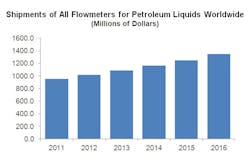As oil production takes off, it’s Coriolis flowmeters that lead the revenue pack to measure petroleum liquids. In fact, the market for new-technology petroleum liquid flowmeters is expected to see a compound annual growth rate (CAGR) of 10.7 percent from 2011 through 2016. That compares with the 2.4 percent growth expected from traditional technologies, according to new studies from Flow Research.
All in all, the worldwide market for flowmeters used for measurement of petroleum liquids totaled $956 million in 2011, and is projected to increase to almost $1.4 billion in 2016. Even in 2001, new-technology meters made up more than half of that total.
Coriolis flowmeters are widely used for downstream custody transfer applications of petroleum liquids, competing with positive displacement meters. They are also widely used for process measurement, allocation metering, and measurement of liquefied natural gas (LNG). Crude oil has been selling in the range of $100 per barrel, and these high prices have placed a premium on highly accurate and reliable flow measurement. Coriolis flowmeters are well-suited to fill this need.
Ultrasonic flowmeters also play an important role in the measurement of petroleum liquids. The oil and gas and refining industries account for more than half of industry revenues for ultrasonic flowmeters. They are widely used both for process measurement and for custody transfer of oil. Even though ultrasonic flowmeters are not as widely used for oil flow measurement as for gas flow measurement, they play an important role in this critical measurement.
Differential pressure (DP) flowmeters still lead the oil flow measurement market in terms of units sold. They have been around for more than 100 years, and cost substantially less than Coriolis and ultrasonic meters. Their price makes them suited to applications where high accuracy is not critical, such as those not involving custody transfer. They are also the best solution for some subsea applications involving high pressures. Turbine flowmeters are the second-leading flowmeter for petroleum liquid applications in terms of units, though not in terms of revenues.
The series of six studies, The World Market for Oil Flow Measurement, analyzes not only flow measurement in the oil and gas industry, but also oil and gas production and reserves worldwide.
“Natural gas and oil will be with us for many years to come,” said Jesse Yoder, president of Flow Research. “While renewables hold great promise for the future, more research and development is required to make their cost competitive with fossil fuels. And, while natural gas holds promise as a long-term bridge to renewables, crude oil still remains the energy source of choice for many applications. Our studies show that the world still has vast reserves of both crude oil and natural gas. As long as these powerful energy sources can be used in an environmentally responsible way, they will continue to play a major role in the energy equation for the foreseeable future.”
Flow Research’s analysis shows that the Mideast/Africa region is the leading producer of crude oil, accounting for 41.3 percent of worldwide crude oil production in 2011. This same region held more than 60 percent of worldwide crude oil reserves in 2011. By contrast, Japan, China and Asia-Pacific accounted for only 10 percent of world production in 2011. The contrast is even more pronounced in crude oil reserves. Japan, China and Asia-Pacific held less than 3 percent of the world’s crude oil reserves in 2011.
Asia’s lack of crude oil production and reserves creates an opportunity for the oil-rich countries of the Middle East, as well as the U.S. and Europe, analysts reported. A similar imbalance exists among the regions for natural gas production and reserves. Because many Asian countries are surrounded by water, much of the imported natural gas comes in the form of LNG. This presents multiple opportunities for custody transfer measurement of both natural gas and LNG. Some companies have taken advantage of the development of shale oil and shale gas to increase their exports to Asia-Pacific countries.
The high price of crude oil has also increased the demand for consistently more accurate and reliable flow measurement. For the past three months, West Texas Intermediate (WTI) crude oil has been selling in the range of $100 per barrel, while Brent crude has sold at an even higher price. This makes drilling profitable in more locations and increases the opportunities for upstream flow measurement. This trend has especially benefited ultrasonic and Coriolis flowmeters.
About the Author
Aaron Hand
Editor-in-Chief, ProFood World

Leaders relevant to this article:
